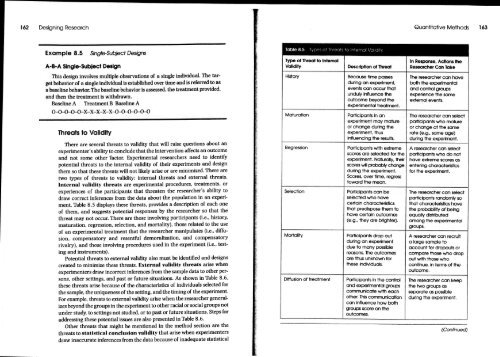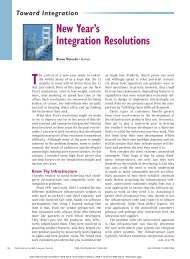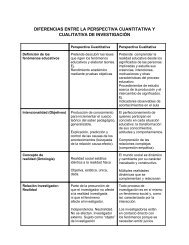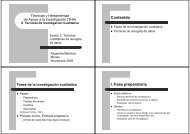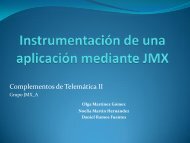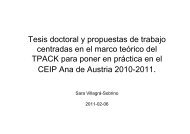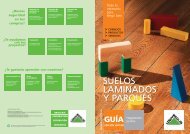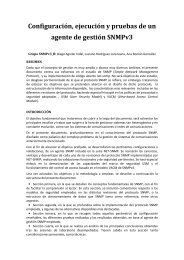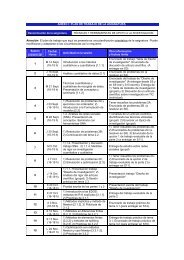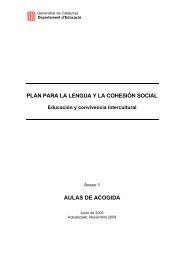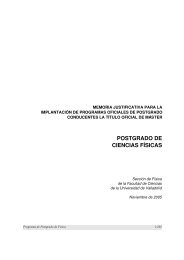Research Questions and Hypotheses
Research Questions and Hypotheses
Research Questions and Hypotheses
Create successful ePaper yourself
Turn your PDF publications into a flip-book with our unique Google optimized e-Paper software.
162 Designing <strong>Research</strong><br />
Quantitative Methods 163<br />
Example 8.5 Single-Subject Designs<br />
A-B-A Single-Subject Design<br />
This design involves multiple observations of a single individual. The target<br />
behavior of a single individuá is established over time <strong>and</strong> is referred to as<br />
a baseline behavior. The baseline behavior is assessed, the treatment provided,<br />
<strong>and</strong> then the treatment is withdrawn.<br />
Baseline A Treatment B Baseline A<br />
0-0-0-0-0—x—X—x—X—X-0—G-0-0-0-0<br />
Threats to Validity<br />
There are severa) threats to validity that will raise questions about an<br />
experimenter's ability to conclude that the intervention affects an outcome<br />
<strong>and</strong> not some other factor. Experimental researchers need to identify<br />
potential threats to the interna) validity of their experiments <strong>and</strong> design<br />
thern so that these threats will not likely arise or are minimized. There are<br />
two types of threats to validity: interna) threats <strong>and</strong> externa) threats.<br />
Interna' validity threats are experimental procedures, treatments, or<br />
experiences of the participants that threaten the researcher's ability to<br />
draw correct inferences from the data about the population in an experiment.<br />
Table 8.5 displays these threats, provides a description of each one<br />
of them, <strong>and</strong> suggests potential responses by the researcher so that the<br />
threat may not occur. There are those involving participants (i.e., history,<br />
maturation, regression, selection, <strong>and</strong> mortality), those related to the use<br />
of an experimental treatment that the researcher manipulates (i.e., diffusion,<br />
compensatory <strong>and</strong> resentful demoralization, <strong>and</strong> compensatory<br />
rivalry), <strong>and</strong> those involving procedures used in the experiment (i.e., testing<br />
<strong>and</strong> instruments).<br />
Potential threats to externa) validity also must be identified <strong>and</strong> designs<br />
created to minimize these threats. External validity threats arise when<br />
experimenters draw incorrect inferences from the sample data to other persons,<br />
other settings, <strong>and</strong> past or future situations. As shown in Table 8.6,<br />
these threats arise because of the characteristics of individuals selected for<br />
the sample, the uniqueness of the setting, <strong>and</strong> the timing of the experiment.<br />
For example, threats to externa) validity arise when the researcher generalizes<br />
beyond the groups in the experiment to other racial or social groups not<br />
under study, to settings not studied, or to past or future situations. Steps for<br />
addressing these potential issues are also presented in Table 8.6.<br />
Other threats that might be mentioned in the method section are the<br />
threats to statistical conclusion validity that arise when experimenters<br />
draw inaccurate inferences from the data because of inadequate statistical<br />
Table 8.5 Types of Threats to Interna' Validity<br />
Type of Threat to Interna!<br />
Validity<br />
History<br />
Maturation<br />
Regression<br />
Selection<br />
Mortality<br />
Diffusion of treatment<br />
Description of Threat<br />
Because time passes<br />
during an experiment,<br />
events can occur that<br />
unduly influence the<br />
outcome beyond the<br />
experimental treatment.<br />
Participants in an<br />
experiment may mature<br />
or change during the<br />
experiment, thus<br />
influencing the results.<br />
Participants with extreme<br />
scores are selected for the<br />
experiment. Naturally, their<br />
scores will probably change<br />
during the experiment.<br />
Scores, over time, regress<br />
toward the mean.<br />
Participants can be<br />
selected who have<br />
certain characteristics<br />
that predispose thern to<br />
have certain outcomes<br />
(e.g., they are brighter).<br />
Participants drop out<br />
during an experiment<br />
due to many possible<br />
reasons. The outcomes<br />
are thus unknown for<br />
these individuals.<br />
Participants in the control<br />
<strong>and</strong> experimental groups<br />
communicate with each<br />
other. This communication<br />
can influence how both<br />
groups more on the<br />
outcomes.<br />
In Response, Actions the<br />
<strong>Research</strong>er Can Take<br />
The researcher can have<br />
both the experimental<br />
<strong>and</strong> control groups<br />
experience the same<br />
externa, events.<br />
The researcher can select<br />
participants who mature<br />
or change at the same<br />
rate (e.g., same age)<br />
during the experiment.<br />
A researcher can select<br />
participants who do not<br />
have extreme scares as<br />
entering characteristics<br />
for the experiment<br />
The researcher can select<br />
participants r<strong>and</strong>omly so<br />
that characteristics have<br />
the probability of being<br />
equally distributed<br />
among the experimental<br />
groups.<br />
A researcher can recruit<br />
a large sample to<br />
account for dropouts or<br />
compare those who drop<br />
out with those who<br />
continue, in terms of the<br />
outcome.<br />
The researcher can keep<br />
the two groups as<br />
separate as possible<br />
during the experiment.<br />
(Continued)


